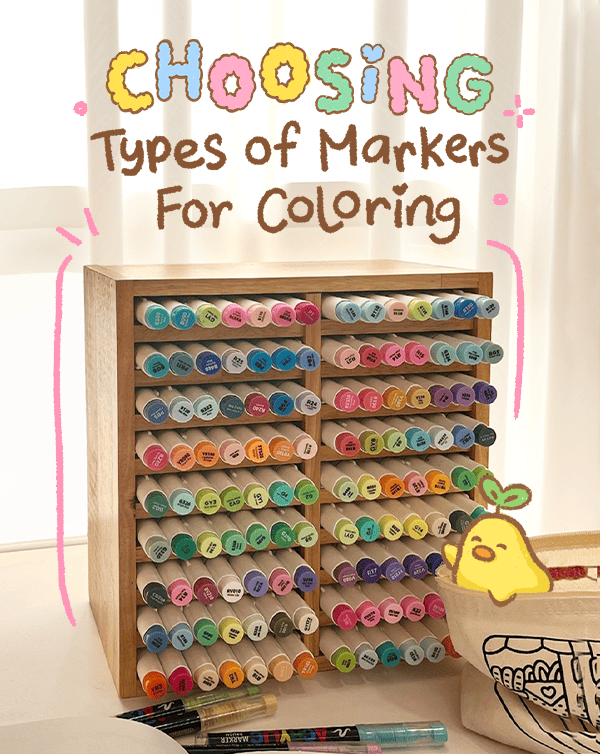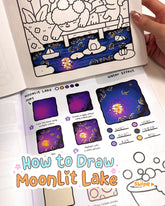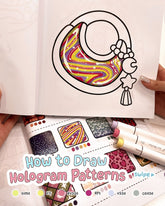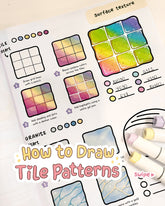How to Choose the Right Types of Markers for Coloring
Table of Contents
Choosing the right types of markers can make coloring feel easier, more relaxing, and a lot more fun, especially when you're new to it. With so many options out there, it can be hard to know which ones are smooth, which ones bleed, or which ones work best with your coloring books.
That’s why we made this simple, friendly guide to help you find the best type of markers for coloring that feel just right for you.
Benefits of Coloring with Markers
Bold, Smooth Color
Markers give you rich, even color in just one stroke. No pressing hard, no layering forever just smooth, vibrant results that make your page pop.
They’re perfect for filling large spaces or adding sharp detail, and the color stays consistent every time.
Easy Relaxation
There’s something calming about the way markers glide across paper. It’s smooth, it’s satisfying, and it gives your hands something gentle to do while your mind slows down.
No sharpening, no mess, just open the cap and go. It’s a simple, satisfying way to unwind and reset your mind.
Room to Explore
Markers are great for trying new things. You can blend, layer, or add accents with ease.
Many sets even come with dual tips, fine on one end, brush or chisel on the other, giving you more control and freedom to explore your style.
Beginner-Friendly
If you’re new to coloring, markers are easy to use.
They give quick, rewarding results, no fancy techniques needed. Just color and enjoy.
Different Types of Markers for Coloring
If you’re new to coloring, picking your first set of markers can feel a bit confusing. Don’t worry, we’ve got you covered. Below is all about different types of markers so you can feel more confident and relaxed as you explore your creative journey.
Alcohol-Based Markers

- Creating bold, saturated colors
- Blending shades together for smooth transitions (like skin tones or shadows)
- Coloring large areas evenly without streaks
What to watch out for:
- These markers can bleed through thin paper, so it’s best to use them on thicker paper (like cardstock) or coloring books labeled as “marker-friendly”.
- The ink has a slight alcohol scent, some people are sensitive to it.
Helpful tips:
- Always put a sheet of paper or cardboard behind your page to protect the next one.
- Start with light pressure these markers are juicy and don’t need much force.
- For blending, use two similar shades and work while the ink is still wet.
Best for: Intermediate users or beginners ready to explore more advanced techniques like blending and layering.
Water-Based Markers

- Gentle, lighter colors that won’t bleed through most coloring book pages
- Controlled coloring, great for smaller areas or simple designs
- A soft and relaxing coloring experience without any strong odor
What to watch out for:
- Water-based ink may pill or wrinkle paper if you go over the same area too many times
- They usually don’t blend as smoothly as alcohol markers
Helpful tips:
- Avoid layering too much, let the paper dry a bit between strokes.
- These markers are perfect for kids, beginners, or everyday relaxing sessions.
- Use them on standard coloring book paper with no need for special protection sheets.
Best for: New colorists, casual coloring sessions, or people who want less mess and less bleed.
Acrylic Markers

You can use them on paper, wood, fabric, glass, and more, making them one of the most versatile tools in your art kit.
What they’re good at:
- Strong, opaque colors that show up on both light and dark surfaces
- Perfect for mixed media projects, crafts, and DIY art
- Great color variety, including matte and metallic finishes
What to watch out for:
- The paint flows thicker than ink, so it’s not ideal for super detailed coloring pages
- If you press too hard or skip shaking, the paint may blob or come out uneven
- Not all paper types handle paint well, choose thicker or mixed media paper to prevent buckling
Helpful tips:
- Shake well before using and test on scrap paper to get the ink flowing evenly
- Store your markers flat to keep the paint balanced
- Let each layer dry before going over it to avoid smudging
- Try using them alongside other materials like watercolor or traditional acrylics
Best for:
Creative minds who love crafting, decorating, or experimenting with different surfaces. If you enjoy bold color and a paint-like feel in a pen format, it’s right for you.
Gel Markers

What they are:
Gel markers are filled with thick, smooth ink, often with metallic, glitter, or neon effects.
What they're good at:
- Adding fun details and shiny effects to your pages
- Highlighting areas like stars, jewelry, magic elements, or accessories
- Writing or decorating cards and journal page
What to watch out for:
- The ink takes longer to dry, so be careful not to smudge
- Not designed for coloring large areas, they're better for accents and finishing touches.
Helpful tips:
Let your gel ink dry for 10 - 15 seconds before touching or turning the page
- Use them over flat-colored areas to add sparkle
- Keep the caps tightly closed so the ink doesn't dry out
Best for: Adding small creative highlights, finishing pages with flair, or mixing with other marker types.
Brush Markers

What they are:
Brush markers have flexible tips that feel a bit like a paintbrush. You can press lightly for thin lines or press harder for thick strokes.
What they’re good at:
- Creating flowy, expressive strokes
- Adding a soft watercolor feel (especially with water-based brush pens)
- Doing hand lettering, calligraphy, or coloring intricate patterns
What to watch out for:
- It takes a little practice to get the hang of controlling the pressure
- The tips can fray if used on rough paper or pressed too hard
Helpful tips:
- Use smooth paper to protect the brush tips and keep lines clean
- Practice your strokes before jumping into detailed work
- Try using one brush marker for outlines and another for filling in, it adds fun contrast
Best for: Those who love expressive coloring styles, experimenting with textures, or combining art and lettering.
| Marker Type | Pros | Cons |
| Alcohol-Based | Vibrant colors, smooth blending, streak-free finish, quick drying | Bleeds through thin paper, has alcohol smell, higher cost |
| Water-Based | Beginner-friendly, soft colors, minimal bleed-through, low odor | Can wrinkle paper if overused, limited blending ability |
| Acrylic | Works on multiple surfaces, opaque coverage, good for layering | Thicker ink flow, not great for fine details, needs thick paper |
| Gel | Adds metallic or glitter effects, great for highlights and accents | Slow drying, can smudge, not suitable for large areas |
| Brush | Flexible strokes, ideal for calligraphy and expressive styles | Requires practice, brush tip may fray, not ideal on rough paper |
How to Choose the Right Types of Markers
Here are 6 simple things to consider:
Know Your Coloring Style
What do you enjoy most?
Do you love realistic details, soft florals, bold patterns, or whimsical designs? Your coloring style helps guide which different types of markers will work best. There’s no right or wrong, just what fits you.
Think About Color Intensity
For bright, bold colors that really pop, alcohol-based markers are a top pick.
If you prefer soft, gentle tones, water-based markers are a better match. And if you love sparkles or shine, gel pens can add fun finishing touches.
Match Your Paper to Your Marker
Your paper matters more than you might think.
Alcohol markers often bleed through thinner pages, so go with thicker or marker-friendly paper. Water-based and gel markers are easier on regular coloring books, but it’s still a good idea to place a spare sheet behind your page just in case.
Be Honest About Your Skill Level
Just starting out? Water-based markers are super beginner-friendly and easy to control.
If you’re feeling curious about blending or shading, alcohol markers or brush pens can help you experiment. No pressure - just go at your own pace.
Think About Convenience
If you’re sensitive to smells, alcohol-based markers might not be ideal.
Look for markers that have secure caps, don’t dry out easily, and are easy to store or carry around. The best tools are the ones you’ll actually want to use often.
Choose Based on Technique
Want smooth gradients and pro-level blends? Go for alcohol markers.
Love expressive strokes or lettering? Try brush markers. Want to add shimmer or texture? Gel markers and metallics are your go-to.
Testing Different Types of Markers

With so many different types of markers out there, it can be hard to know what really fits your style.
But here’s the good news: you don’t need to decide all at once.
Start with a Small Assortment
Before you invest in a full set, try picking up a few individual markers or a small variety pack. Look for a mix of ink types (like water-based, gel, and alcohol-based) and different tip styles (fine, chisel, brush).
This gives you a feel for how each one behaves and more importantly, how they feel in your hand.
Swatch on the Paper You’ll Actually Use
Not all paper handles ink the same way. So before you start coloring for real, test your markers on the same paper you'll be using.
Check for things like:
- Bleed-through (does the ink soak through to the back?)
- Feathering (do the edges of the line stay sharp or spread out?)
Watch Dry Time and Blending
Some inks dry super fast. Others need a moment to settle, and if you're layering or blending, that really matters.
With some types of alcohol markers, for example, you can blend beautifully while the ink is still wet. Water-based markers, on the other hand, may not blend as easily but are less likely to bleed through.
Pay attention to how the colors react as you layer them. Do they build up nicely? Do they leave streaks? These little tests go a long way in helping you find your favorites.
Trust Your Creative Gut
If a marker feels good to use and makes you want to keep coloring, that’s a great sign.
What feels right for you might be different from someone else and that’s totally okay. Testing helps you find your perfect match.
Final Thoughts
Choosing the right types of markers is a playful journey, one that blends relaxation with creativity in the true spirit of Coco Wyo. By understanding basic marker types, testing them out, and following a few simple tips, you’ll be well on your way to creating colorful masterpieces that reflect your unique style.
FAQs
What’s the difference between alcohol vs water based markers?
Alcohol-based markers offer vibrant colors and smooth blending but often bleed through paper. Water-based markers are less prone to bleeding, making them more suitable for coloring books with thinner pages.
Do all alcohol-based markers bleed through paper?
Yes, alcohol-based markers typically bleed through most papers. Using thicker paper or placing a protective sheet beneath the page can help manage this issue.
Are there affordable markers that blend well and don't streak?
Finding affordable markers that blend well and minimize streaking can be challenging. Alcohol-based markers generally offer better blending capabilities, but they may come at a higher price point.
When were markers invented?
Markers were invented in 1953 by Sidney Rosenthal, who created the first felt-tip marker called the “Magic Marker.” It featured a glass bottle filled with ink and a felt writing tip, and quickly became popular for labeling, posters, and art.
What are dual-tip markers, and what are their advantages?
Dual-tip markers feature two different tips, commonly a brush tip and a fine or chisel tip. This design offers versatility, allowing artists to switch between broad strokes and fine details without changing tools.
How should I store markers to extend their lifespan?
Store markers horizontally to prevent ink from settling at one end. Ensure caps are tightly closed to prevent drying, and keep them in a cool, dry place away from direct sunlight.
What are paint markers, and how do they differ from regular markers?
Paint markers dispense opaque, pigmented paint through a valve-action tip, allowing for application on various surfaces, including metal, glass, wood, and plastic. Unlike regular markers that use dye-based inks, paint markers provide vibrant, long-lasting color that sits atop the surface.
Can markers be refilled or have their tips replaced?
Some high-quality markers, like Copic markers, are designed to be refillable and have replaceable nibs. This feature makes them more cost-effective over time and environmentally friendly compared to disposable marker.
What are alcohol-based markers used for?
Alcohol-based markers are commonly used for professional illustration, design, fashion sketching, and coloring due to their vibrant colors, smooth blending, and fast-drying ink. They're ideal for layering and creating gradients on marker-friendly paper.
What are the best markers for coloring?
The best markers for coloring include Copic for professionals, Prismacolor for rich colors and blending, and Crayola for beginners. Each offers smooth application and vibrant results. Choose based on your budget, skill level, and preferred coloring style.











